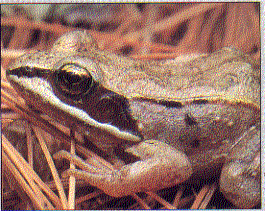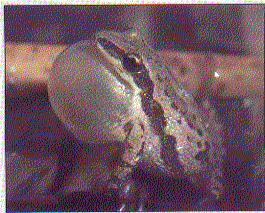|
|
|
|
North Dakota |
Here are the only four species of frogs that live in North Dakota. |
|
Northern leopard frogs are found throughout North Dakota in almost any body of water. Their color may vary from green to gray and the spots may or may not be present. They are powerful swimmers and can leap five to six feet to avoid capture. These frogs are one of the first amphibians to emerge from hibernation in the spring. Their diet includes insects, worms, and other frogs. Another name for this frog is "meadow frog." During the summer you may encounter these frogs far away from water. |
|
|
Wood frogs have a characteristic dark mask around the eyes. There is a great variation in the color of the wood frog-- from pink, to brown, to black. No matter what color is described the dark mask is always present. Wood frogs are found near moist woodlands, and they are very reclusive. In the winter they hibernate under dead logs, piles of rocks, and dead leaves. In the spring they are one of the first frogs to emerge from hibernation. Their diet includes insects and worms. This frog is found farther north than any other frog. They have been found in shallow ponds in the Canadian tundra. |
 |
|
Western chorus frogs are North Dakota's smallest frogs, reaching a body length of 1 1/2 inches. Colors range from buff to gray, or green with three dark stripes down the back. Chorus frogs have small adhesive discs like tree frogs, but they do not climb. Their diet consists of small insects. Chorus frogs are best known for their distinctive call. From the middle of April to the middle of June, you can hear their call. It has been descibed as a chirping noise. These frogs can be found statewide. |
 |
|
Gray tree frogs have the remarkable capacity to change their color from gray to brown or green within a few minutes. They are mediun-sized frogs that can grow to approximately two inches in length. Their toes are tipped with adhesive discs which enable them to climb and cling to smooth branches and leaves. They are often seen on roadways hunting for insects on warm, humid, summer nights. During the day they prefer the shade and protection of trees and shrubs near water. Their diet consists mainly of insects. They are found throughout the aspen woodlands of northeastern North Dakota. |
 |